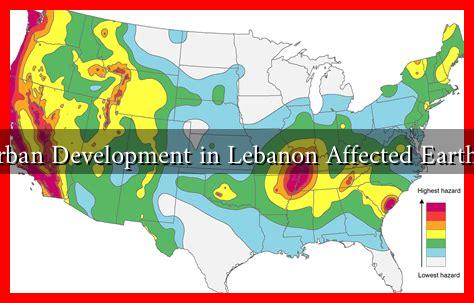-
Table of Contents
How Has Urban Development in Lebanon Affected Earthquake Risk?
Lebanon, a country characterized by its rich history and diverse culture, is also situated in a seismically active region. The urban development patterns in Lebanon have significant implications for earthquake risk, particularly in the context of increasing urbanization and inadequate infrastructure. This article explores how urban development in Lebanon has influenced earthquake risk, examining the challenges and potential solutions.
The Seismic Landscape of Lebanon
Lebanon is located along the boundary of the Arabian and Eurasian tectonic plates, making it susceptible to earthquakes. The country has experienced several significant seismic events, including the devastating 551 AD earthquake that destroyed much of Beirut. More recently, the 1999 earthquake in the region of Qana highlighted the ongoing seismic threat.
. According to the Lebanese National Center for Geophysics, Lebanon experiences an average of 10 to 15 minor earthquakes annually, with the potential for larger, more destructive events.
Urbanization Trends in Lebanon
Lebanon has undergone rapid urbanization, particularly since the end of the Lebanese Civil War in 1990. The population of Beirut has surged, leading to increased construction and development. Key trends include:
- Population Growth: Beirut’s population has grown from approximately 1 million in the 1990s to over 2 million today, leading to a housing crisis.
- High-Rise Buildings: The construction of high-rise buildings has become prevalent, often without adequate seismic considerations.
- Informal Settlements: Many residents live in informal settlements that lack proper infrastructure and are particularly vulnerable to seismic events.
Impact of Urban Development on Earthquake Risk
The rapid urban development in Lebanon has exacerbated the risks associated with earthquakes in several ways:
- Inadequate Building Codes: Many buildings are constructed without adherence to modern seismic building codes, increasing the likelihood of structural failure during an earthquake.
- Overcrowding: High population density in urban areas leads to overcrowded living conditions, making evacuation during an earthquake more challenging.
- Infrastructure Strain: The existing infrastructure, including roads and emergency services, is often insufficient to handle the demands of a major seismic event.
Case Studies: Lessons from Past Earthquakes
Examining past earthquakes can provide valuable insights into the consequences of urban development in Lebanon:
- 1999 Qana Earthquake: This earthquake resulted in significant damage to buildings, many of which were not built to withstand seismic activity. The lack of preparedness highlighted the need for improved building regulations.
- 2019 Beirut Building Collapse: A building collapse in Beirut, attributed to poor construction practices, underscored the risks posed by inadequate urban planning and enforcement of building codes.
Mitigation Strategies and Future Directions
To address the challenges posed by urban development and earthquake risk, Lebanon must adopt comprehensive mitigation strategies:
- Strengthening Building Codes: Implementing and enforcing strict building codes that prioritize seismic safety is essential.
- Public Awareness Campaigns: Educating the public about earthquake preparedness can enhance community resilience.
- Urban Planning Reforms: Integrating seismic risk assessments into urban planning processes can help guide sustainable development.
Conclusion
Urban development in Lebanon has significantly influenced earthquake risk, with rapid urbanization and inadequate infrastructure compounding the challenges faced by the country. As Lebanon continues to grow, it is imperative to prioritize seismic safety in building practices and urban planning. By learning from past experiences and implementing effective mitigation strategies, Lebanon can enhance its resilience to future seismic events. The need for a proactive approach is clear: safeguarding lives and property in a country that is no stranger to the forces of nature.
For more information on earthquake preparedness and safety measures, you can visit the Ready.gov Earthquakes website.





